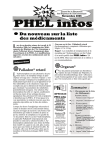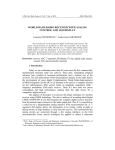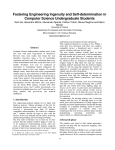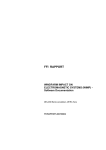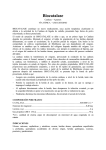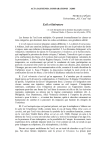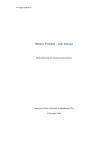Download THE USER'S GUIDE FOR THE AUTHORS
Transcript
THE PUBLISHING HOUSE OF THE ROMANIAN ACADEMY MEDICINE Research article GINGIVAL OVERGROWTH AS SECONDARY EFFECT OF CALCIUM CHANNEL BLOCKERS ADMINISTRATION – A CASE REPORT MIRONIUC-CUREU MAGDALENA1, DUMITRIU ANCA-SILVIA2, SUCIU IOANA3, STOIAN IRINA4 and GHEORGHIU IRINA MARIA5 1 Professor Assistant, Departament of Periodontology, Faculty of Dental Medicine, UMF “Carol Davila”, Bucharest Associate Professor, Departament of Periodontology, Faculty of Dental Medicine, UMF “Carol Davila”, Bucharest 3 Associate Professor, Department of Endodontics, Faculty of Dental Medicine, UMF “Carol Davila”, Bucharest 4 Associate Professor, Department of Biochemistry, Faculty of Medicine, UMF “Carol Davila’’ Bucharest 5 Professor Assistant, Departament of Operative Dentistry, Faculty of Dental Medicine, UMF “Carol Davila”, Bucharest Corresponding author: Mironiuc-Cureu Magdalena, E-mail: [email protected] 2 Received March 22, 2014 Gingival overgrowth is, among other things, a side effect of administration of dihydropyridine antihypertensives, generally associated with irritant factors of marginal periodontium. This case refers to a patient, female, who developed a large gingival enlargement and combines elements associated with managing lercandipina and presence of dental bridges incorrectly adjusted to the dental cervix. Solving involved a complex local treatment (antimicrobial, surgical, endodontic and prosthetic) and collaboration with specialist cardiologist. Maintaining of normal gingival parameters depends on the possibility of changing antihypertensive medication, the accuracy of dental bridges and periodic visits of the patient. Key words: Gingival overgrowth, calcium channel blockers, gingivectomy. INTRODUCTION Gingival overgrowth (gingival hyperplasia) have a multiple etiology, starting with bacterial origin which are associated with various local factors (decays, bad adapted prosthesis, malocclusions, etc.), and continuing with those which appear in the systemic diseases (diabetes, leukemia, immunodeficiency disease) or as a side effect of certain medications (calcium channel blockers, phenytoin, cyclosporine) and up to the idiopathic hyperplasia (gingival elephantiasis). Quite common is gingival hyperplasia as a side effect of drugs administration of calcium antagonists, because the incidence of hypertension is higher in patients aged three, and in their treatment are often used drugs as calcium channel blockers. Many authors have cited the involvement of calcium antagonists in gingival hyperplasia pathogenesis by changes both in the epithelium and the chorion. The epithelial hyperplasia is not Proc. Rom. Acad., Series B, 2014, 16(2), p. 73–75 caused by proliferation of keratinocytes but by increasing their lifetime with decreasing apoptosis. Connective tissue accumulates collagen components by decreasing phagocytic activity reducing collagen degradation, which are closely correlated with the accumulation of type I collagen 1. The size of hyperplasia depends on many factors such as: time of drug administration, the daily dose, combination with other factors, local irritation and individual host response. Studies of Ellis (see in [4]) have shown that calcium antagonists with mainly vascular effects cause most common gingival hypertrophy, and one of these is nifedipine who produce gingival hyperplasia at a dose of 10 mg daily, because its accumulation in gingival sulcus of 15–316 times more than in the blood. MATERIAL AND METHODS The patient presented in this article is 55 years old, female, diagnosed with hypertension, with a history of 74 Mironiuc-Cureu Magdalena et al. stroke (2009). Its antihypertensive medication include: Nebilet, Leridip, Noliterax alongside Sortis and Aspenter. Among these Leridip product (lercandipinum) is a calcium channel blocker from group of dihydropyridines, being administered for 4 years, daily dose 10mg. This drug in combination with the presence of fixed prosthetic teeth incorrectly adjusted at the dental cervix leads to develop an extensive gingival overgrowth interesting interdental papilla, free gingival margin and partially fixed gingiva (Figure 1). At presentation, periodontal indices had the following values: PI = 61.61%, TI = 45%, BI = 36.34%. Parodontometry shows deep pockets between 3 to 7.5 mm. The panoramic radiography shows lack of adaptation to the dental crowns, and a vertical bone resorption especially in the upper front teeth and 2.4 (Figure 2). Initial local therapy consisting in supra and subgingival scaling, repeated local applications with antibiotics paste (tetracycline and metronidazole) was associated with general treatment with antibiotics (Amoxicillin + Metronidazole 250 mg 3/day 500 mg 3/day for 7 days). We obtain a reduction of inflammation with gingival color normalization, reducing gingival bleeding and volume (Figure 3). It was decided to proceed to gingivectomy on the upper jaw to remove the gum in excess, in two times, one for each half of upper jaw. It started with quadrant I. After a preliminary pocket depth marking with forceps Krane Kaplan, we perform a horizontal external bevel incision, followed by secondary incisions in sulcus. We removed gum hyperplasia and proceed to gingival curettage and root planning. After lavage with saline we protected the wound by periodontal dressing. This was removed after 48 hours (Figures 4, 5, 6, 7). In Figure 8 we can observe gingival aspect after a month from surgery, keeping the normal appearance and color of the gums, with a slight granulation tissue between 1.3 and 1.4 due retentive dental bridge at that level. After 4 weeks the same intervention was done in quadrant II (Figures 9, 10, 11, 12). RESULTS It was obtained the lack of periodontal pockets, resulting in a better gingival aspect, with normal color, volume and consistency. After 3 weeks from the second gingivectomy, the patient was sent to prosthetician to remove the dental bridge and restore it. Tooth no 2.4 extraction was necessary due to advanced bone resorption and endodontic treatments were restored. The prosthetician decided to make an acrylic temporary bridge with supragingival margins for a period of 3 months to stabilize the gingiva and restore the alveolar ridge after extraction. After this, the prosthetician will make the final bridge. To avoid the relapse we recommended a visit at cardiologist and for changing antihypertensive medication, by replacing the calcium channel blockers with other antihypertensive drugs of a different class. DISCUSSION Calcium antagonists are substances that inhibit the flow of calcium ions through the slow channel membrane. The therapeutic consequences are the inhibition of myocardial contraction, depression of myocardial function, specifically generating potential slow (sinus and atrioventricular node, antiarrhythmic effect, bradycardia) and relaxation of smooth muscle, particularly in the vessels, with vasodilator effect 2. Calcium antagonists are classified into two categories, each having in principal vascular effects (Nifedipine, Nimodipine, Nicardipine, Flodipina, amlodipine), and the other having main effects on heart (Verapamil, Diltiazem). From the pharmacological point of view, are classified as: family dihydropyridine (prototype Nifedipine), non-dihydropyridine family in fact phenlalkylamine (Verapamil) and family benzothiazepine (Diltiazem). Among these groups of calcium channels blocked, the dihydropyridine family are responsible of gingival enlargement. Most studies have been done on nifedipine, which seems to occur most frequently gingival hyperplasia. Increase of gingival is installed after 20 days of administration of nifedipine and gingival mass is constant after 70 days. Were measured also gingival enlargement in treatments with amlodipine and lercanidipine. It seems that isradipine not causes gingival hyperplasia occurs. The volume of hyperplasia depends on the daily dose (more than 10mg), the time of administration, gender (men are more likely than women) and the presence of plaque and local irritation factors (decays, the incorrectly dental bridges, etc.) 3 The clinical aspects include enlargement of the papillae, which take the appearance of masses of connective tissue, which can reach the occlusal plane. Gum may be nodular appearance, color ranging from red-violet to red-congestion. Rarely epithelial junction can migrate to the apical, giving rise to real periodontal pockets. On histological cups we find the dystrophia in epithelium, cell segregation and acanthosis in the Gingival overgrowth as secondary effect of calcium channel stratum spinosum, hyperkeratosis and parakeratosis, the presence of fibrous bands in chorion, dilated blood vessels, with teleangiectazic aspect, rich limfoplasmocitar inflammatory infiltrate in gingival chorion 4. In a study by researchers at Nanjing Medical University nifedipine has been shown to induce changes on Keratinocyte growth factor (KGF) and its receptor (KGFR). Epithelial keratinocytes and mesenchymal fibroblasts may interplay to dynamically regulate gene expression, which may have an effect on the gingival condition following treatment with nifedipine 5. A study by Claude M. Kanno at all 6 suggest that collagen fibers accumulation can be attributed to a decrease of destroying rather than an increase in synthesis . Lifetime and mechanism of collagen structural remodeling are controlled predominantly by enzymes such as collagenase and proteolytics from metalloproteinase family. Members of this family of enzymes may specifically trigger digestion of collagen but also the structural components of the extracellular matrix. Maturation of collagen fibers was observed while coloring varying due to development in green, yellow, orange and red. Existence of type III collagen was observed, it is considered an immature form of collagen that participate in tissue remodeling. Clinical case presented in this article showed gingival hyperplasia when administered 10mg daily Leridip (Lercandipinum) along with Nebilet and Noliterax. In addition prosthetic restorations, especially the upper arch were not correctly adapted to the tooth cervix. In addition physiognomic compounds (acrylate) presents lack of finishing and polishing at the margins. From X-ray it observe that bone loss is quite advanced, indicating a deep chronic marginal periodontitis associated with gingival overgrowth due to lercandipinum (second generation of dihydropyridine). CONCLUSIONS AND FUTURE PROSPECTS Given that the prevalence of gingival hyperplasia as a side effect of antihypertensive medication with calcium antagonists is 30–50%, it requires an assessment of periodontal status before 75 prescribing them, and after the substance accumulates in the body. It is better to use other antihypertensive calcium antagonists in case of a pre-existing a periodontium disease. However, if their use is necessary, patients should call at every 6 months for a proper debridment. Always bear in mind and evaluate existing prosthetic restaurations, the fillings and other common factors that may influence local gingival hyperplasia volume. In hypertensive patients with risk of gingival overgrowth is better to exist an collaboration between the dentist and cardiologist to maintain periodontal health and improve quality of life. ACKNOWLEDGEMENT Daniela Lixandru acknowledges the postdoctoral program POSDRU/89/1.5/S/60746, from European Social Fund. REFERENCES 1. Masatoshi Kataoka,Yasuki Shimizu,Kenji Kunikiyo,Yoji Asahara,Hideki Azuma,Takamasa Sawa,Jun-ichi Kido, Toshihiko Nagata (2001), Nifedipine Induces Gingival Overgrowth in Rats Through a Reduction in Collagen Phagocytosis by Gingival Fibroblasts. Journal of Periodontology. Vol. 72, No. 8, Pages 1078-1083. DOI:10.1902/jop.2001.72.8.1078) 2. Dumitriu Anca Silvia, Paunica Stana, Giurgiu Marina Cristina, Cureu Magdalena(2009). Mariri de volum gingival. Clinica şi principii de tratament. Bucureşti: Editura Didactică şi Pedagogică, R.A. 3. Bondon-Guitton E, Bagheri H, Montastruc J-L, The French Network of Regional Pharmacovigilance Centers (2012). Drug-induced gingival overgrowth: a study in the French Pharmacovigilance Database. J Clin Periodontol. 39: 513–518. DOI: 10.1111/j.1600-051X.2012.01878.x. 4. Dumitriu H. T. (2006), Parodontologie (4th ed), Bucuresti: Editura Viata Medicala Romaneasca. 5. Di C-P, Sun Y, Zhao L, Li L, Ding C, Xu Y, Fan Y (2013). Effect of nifedipine on the expression of keratinocyte growth factor and its receptor in cocultured/monocultured fibroblasts and keratinocytes. J Periodont Res. DOI: 10.1111/jre.12064. 6. Cláudia M. Kanno, ¬José A. Oliveira, José F. Garcia, ¬Alvimar L. Castro & ¬Marcelo M. Crivelini (2008). Effects of Cyclosporin, Phenytoin, and Nifedipine on the Synthesis and Degradation of Gingival Collagen in Tufted Capuchin Monkeys (Cebus apella): Histochemical and MMP-1 and -2 and Collagen I Gene Expression Analyses. Journal of Periodontology. Vol. 79, No. 1, Pages 114-122.




